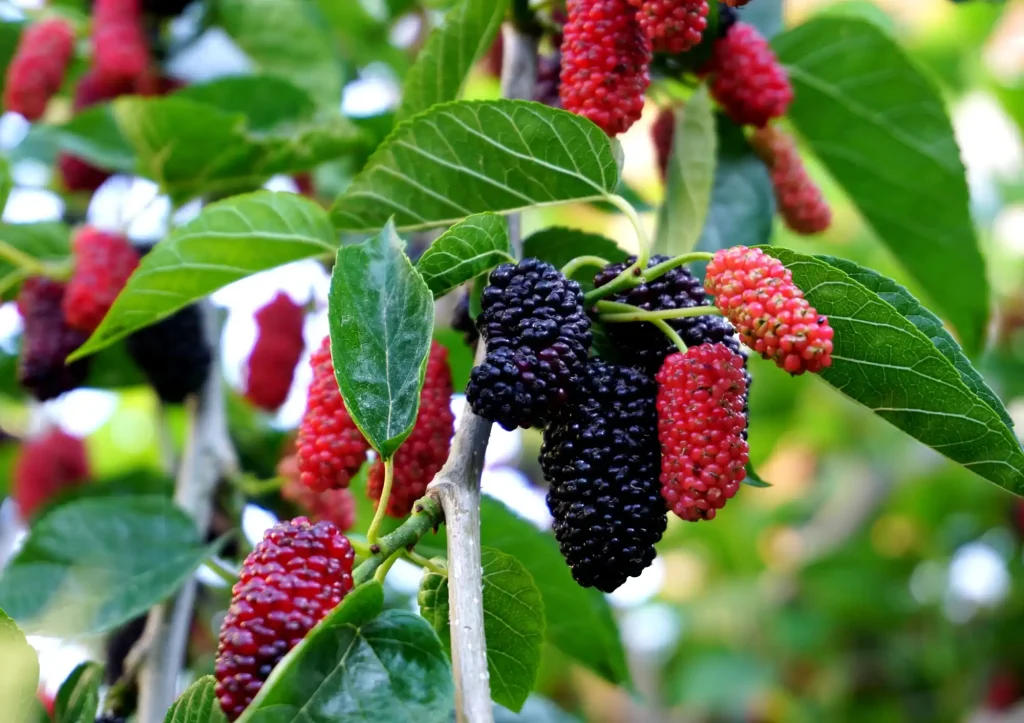JAKARTA, studyinca.ac.id – Mulberries, often overshadowed by more popular fruits, are experiencing a resurgence in interest as consumers and farmers alike recognize their unique flavors, nutritional benefits, and versatility. This article explores the history of Mulberries cultivation, its benefits, and the modern practices that are revitalizing this once-forgotten fruit.
The History of Mulberries Cultivation

Mulberries belong to the Moraceae family and are native to various regions across the world, including Asia, Europe, and North America. Historically, they have been cultivated for their fruit, leaves, and wood. Key points in their history include:
- Ancient Cultivation: Mulberries have been cultivated for thousands of years. The white Mulberries (Morus alba) was notably used in sericulture (silk production) in ancient China, as its leaves are the primary food source for silkworms.
- Culinary Uses: In addition to their role in silk production, mulberries have been used in various culinary applications, including jams, jellies, wines, and desserts. Their sweet, juicy berries are enjoyed fresh or dried.
- Decline in Popularity: With the rise of commercial fruit production and the popularity of other berries, mulberries fell out of favor. Many orchards were abandoned, and knowledge of Mulberries cultivation diminished.
The Comeback of Mulberries
In recent years, there has been a renewed interest in Mulberries cultivation for several reasons:
- Nutritional Benefits: Mulberries are rich in vitamins (such as vitamin C and K), minerals (including iron and potassium), and antioxidants. They are low in calories and high in dietary fiber, making them a healthy choice for consumers.
- Sustainable Agriculture: Mulberries are hardy trees that require less water and fewer pesticides compared to many other fruit crops. Their ability to thrive in diverse soil types makes them an attractive option for sustainable farming practices.
- Market Demand: As consumers seek out unique and nutritious fruits, mulberries are gaining popularity in farmers’ markets and specialty stores. Their versatility in culinary applications also appeals to chefs and home cooks alike.
- Agroforestry Opportunities: Mulberries trees can be integrated into agroforestry systems, providing shade and improving soil health while producing fruit. This practice supports biodiversity and enhances farm resilience.
Cultivation Practices
To successfully cultivate mulberries, farmers should consider the following practices:
- Choosing the Right Variety: There are several species of Mulberries , including white, red (Morus rubra), and black (Morus nigra) mulberries. Selecting the appropriate variety based on climate, soil conditions, and intended use is crucial for successful cultivation.
- Site Selection and Preparation: Mulberries prefer well-drained soils and full sun, although they can tolerate partial shade. Preparing the site by testing soil pH and nutrient levels will help ensure optimal growth.
- Planting and Care: Mulberries can be propagated from seeds, cuttings, or grafting. Proper planting techniques, including spacing and watering, are essential for healthy tree development. Regular pruning helps maintain tree shape and encourages fruit production.
- Pest and Disease Management: While mulberries are relatively pest-resistant, monitoring for common issues such as aphids, spider mites, and fungal diseases is important. Organic pest control methods can be employed to minimize chemical use.
- Harvesting: Mulberries are typically harvested in late spring to early summer, depending on the variety. The berries should be picked when fully ripe, as they do not continue to ripen after being harvested.
Culinary Uses of Mulberries
The resurgence of mulberries can also be attributed to their culinary versatility:
- Fresh Consumption: Mulberries can be eaten fresh, providing a sweet and slightly tart flavor that pairs well with other fruits.
- Preserves and Jams: Their natural sweetness makes mulberries an excellent choice for preserves and jams, allowing for a delicious spread that captures their unique flavor.
- Baking and Cooking: Mulberries can be incorporated into baked goods such as pies, muffins, and bread. They can also be used in savory dishes, adding depth and complexity.
- Beverages: Mulberries can be used to create refreshing juices, smoothies, and even wines, offering a unique alternative to traditional fruit beverages.
Conclusion: A Bright Future for Mulberries Cultivation
Mulberries cultivation is making a comeback as consumers and farmers rediscover this versatile fruit’s unique flavor and nutritional benefits. With sustainable farming practices and innovative culinary applications, mulberries are poised to become a staple in modern agriculture and cuisine.
As interest in locally sourced and unique fruits continues to grow, mulberries present an opportunity for farmers to diversify their offerings and for consumers to enjoy a delicious and nutritious addition to their diets. By embracing Mulberries cultivation, we can help revive this forgotten fruit and ensure its place in the future of agriculture.
Read also about Experiential Education to discover how hands-on learning, real-world engagement, and reflection-based approaches deepen understanding and build practical skills.

